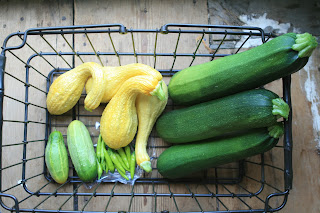
7/29/2012
25 peas
7 pickle cucumber
1 zucchini
5 crook neck yellow summer squash
2 butter cup squash
4 cherry tomatoes
12 lbs
7/30/2012
4 zucchini
3 crook neck yellow summer squash
2 cherry tomatoes
5 lbs
Year to date total:
19 heads of lettuce
33 peas
12 snap peas
30 pickle cucumber
29 zucchini
30 crook neck yellow summer squash
4 baking pumpkins
1 head of broccoli
5 butter cup squash
32 hot peppers
6 cherry tomatoes
lots of basil
Total: 87 lbs
More shots from our garden this season
zucchini, yellow summer squash, butter cup squash, watermelon, pumpkins and potatoes
peppers, cabbage, butter nut squash, broccoli, onions and our wall of tomatoes
tomatoes, onions, carrots and peppers
red cabbage
corn
a bee in our pumpkin flower
watermelon :)
buttercup squash now growing up our fence
mini pumpkins!
Also, this past weekend we canned a batch of kosher dill pickles! Yum!
See the pickle recipe below:
Kosher Dill Pickles Featuring Ball® Kosher Dill Pickle Mix, now with Pickle Crisp® Granules for crunchier pickles! See just how easy it is to make this traditional favorite!
You will need:
For every 2 quarts of pickles: 3 1/2 lbs pickling cucumbers (about 14 small to medium)
2 cups water
1 cup vinegar (5% acidity)
1/4 cup Ball® Kosher Dill Pickle Mix
2 Ball® Quart (32 oz) Fresh Preserving Jars with lids and bands
Directions:
2 cups water
1 cup vinegar (5% acidity)
1/4 cup Ball® Kosher Dill Pickle Mix
2 Ball® Quart (32 oz) Fresh Preserving Jars with lids and bands
Directions:
Prepare Kosher Dill Pickles1. CUT ends off cucumbers. Cut into spears.
2. COMBINE water, vinegar, and Ball® Kosher Dill Pickle Mix in a medium saucepan. Heat to a boil.
3. PACK based on ENJOY NOW or FRESH PRESERVE steps below.
ENJOY NOW (Refrigerate up to 3 months): 1. POUR hot pickling liquid over cucumber spears in a large bowl. Cool to room temperature, about 30 minutes.
2. PACK cucumber spears into jars. Ladle pickling liquid over cucumbers. Place lids and bands on jars.
3. REFRIGERATE pickles. For best flavor, allow pickles to stand in refrigerator for 3 weeks.
-OR-
FRESH PRESERVE (Store up to 1 year): 1. PREPARE canner, jars, and lids according to manufacturer's instructions.
2. PACK spears into hot jars. Ladle hot pickling liquid over spears leaving 1/2 inch headspace. Remove air bubbles. Wipe rims. Center lids on jars. Apply bands and adjust to fingertip tight.
3. PROCESS in boiling water canner for 15 minutes, adjusting for altitude*. For best flavor, allow pickles to stand for 4-6 weeks.
2. COMBINE water, vinegar, and Ball® Kosher Dill Pickle Mix in a medium saucepan. Heat to a boil.
3. PACK based on ENJOY NOW or FRESH PRESERVE steps below.
ENJOY NOW (Refrigerate up to 3 months): 1. POUR hot pickling liquid over cucumber spears in a large bowl. Cool to room temperature, about 30 minutes.
2. PACK cucumber spears into jars. Ladle pickling liquid over cucumbers. Place lids and bands on jars.
3. REFRIGERATE pickles. For best flavor, allow pickles to stand in refrigerator for 3 weeks.
-OR-
FRESH PRESERVE (Store up to 1 year): 1. PREPARE canner, jars, and lids according to manufacturer's instructions.
2. PACK spears into hot jars. Ladle hot pickling liquid over spears leaving 1/2 inch headspace. Remove air bubbles. Wipe rims. Center lids on jars. Apply bands and adjust to fingertip tight.
3. PROCESS in boiling water canner for 15 minutes, adjusting for altitude*. For best flavor, allow pickles to stand for 4-6 weeks.



























